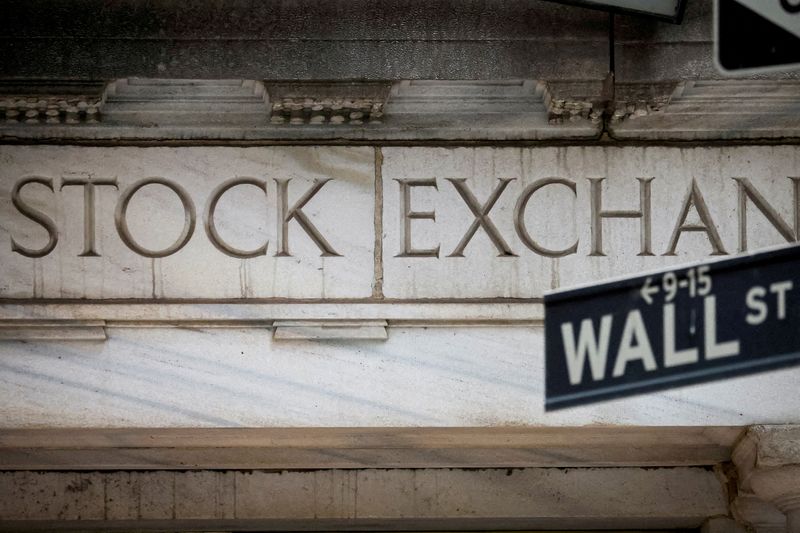By Jamie McGeever
ORLANDO, Florida (Reuters) -Fundamentals or "FOMO?"
Big Tech's resilience, concentration, and unassailable status as Wall Street's driving force have understandably raised concerns of a bubble in the making as the "fear of missing out" buying frenzy fuels a dangerous, self-perpetuating price spiral.
That is partly true, but too simplistic.
While "FOMO" has accelerated tech's remarkable run, plain old "fundamentals" - earnings forecasts, profit margins and valuations - are increasingly playing their part and suggest the upswing can continue into the second quarter and beyond.
Even as the Nasdaq Composite and S&P 500 indexes touch all-time highs, global financial behemoths including BlackRock (NYSE:BLK), Barclays and Societe Generale (OTC:SCGLY) are turning up their positivity on Big Tech - and by extension, U.S. stocks.
As the second quarter of 2024 looms, investors are already looking ahead and asking whether the 2025 earnings outlook justifies the current boom.
In basic terms, it looks like it can.
The I/B/E/S aggregate forward earnings growth forecast for the S&P 500 next year is currently running at 13.6%. That's the highest since 2025 forecasts were first drawn up two years ago, and is up one percentage point since the turn of the year.
It also marks a notable increase on the current 2024 consensus, which is for EPS growth of a still decent 10%. That has been chipped away from around 12% in October, but tech companies are holding their ground more than most.
In dollar terms, that translates to an expected $271 per share next year for the overall index versus $239 this year.
Analysts at the BlackRock Investment Institute note that the acceleration in tech earnings expectations is such that the sector will account for half of this year's total S&P 500 earnings.
They maintain their "overweight" recommendation on U.S. stocks, citing the artificial intelligence (AI) boom that will lift all sectors. "Earnings growth looks robust," they wrote in a note on Monday.
The tide of "U.S. exceptionalism" driving America's economic and market outperformance, of which AI-led tech is a key component, shows no sign of reversing any time soon.
S&P 500 AT 5,500 ... or 6,000?
Earnings forecasts for 2025 have risen despite the hawkish shift in money markets as U.S. inflation and growth have stayed hotter than anticipated.
Analysts at Barclays say one reason for this is the continued widening of Big Tech's profit margins, which they predict will widen to an estimated 23.4% this year from 21.7% last year.
That's nearly twice the overall S&P 500's expected 2024 profit margin of 12.7%, and more than double the broader market ex-tech projection of 10.8%.
"Visibility into earnings growth for the next few quarters is good, and revisions for Big Tech continue to leave the rest of the S&P 500 in the dust," the Barclays team wrote earlier this month.
The ongoing tech boom is one reason why many institutions are raising their S&P 500 forecasts. SocGen's equity team this week raised their 2024 outlook to 5,500, one of the highest on Wall Street and implying a further 6% upside from current levels.
They cited optimism in industrials, their first upgrade of financials since December 2021, and continued resilience in tech - their Nasdaq earnings growth forecast for this year was lifted to 18% from 15%.
If 5,500 for the S&P 500 this year is bullish, what about 6,000?
That's not Goldman Sachs analysts' baseline view, but it is a scenario they say could play out, bearing in mind that long-term growth expectations and valuations for the largest tech stocks are still a long way from "bubble" territory.
Given the degree of market concentration - Big Tech accounts for around a third of the S&P 500's market cap and up to half of its earnings - comparisons are being drawn with the dot-com crash in 2000.
But as Goldman and others note, valuations are simply not that stretched. Big Tech's valuations are down from the post-pandemic peak, only slightly above long-term averages, and are nowhere near where they were a quarter of a century ago.
According to BlackRock's systematic equities team, analysis of 400 metrics related to valuations and other metrics shows that the number "flashing red" is 50% lower than when the dot-com bubble burst.
Of course, stretched positioning, natural market exhaustion, an economic downturn, stickier inflation and tighter-than-expected Fed policy or failure of AI to live up to over-hyped growth expectations could all bring the party to an abrupt end.
The shakeout will be painful for many investors. Goldman Sachs analysts note that each mega-cap tech stock except Tesla (NASDAQ:TSLA) is among their hedge fund clients' favorite long positions.
But as long as tech profits continue to pile up, investors will be inclined to stay "all in."
"While Big Tech shoulders its fair share of risks, we do not see anything to argue against the group's continued outperformance from a fundamental perspective over the near term," according to Barclays.
(The opinions expressed here are those of the author, a columnist for Reuters.)
(By Jamie McGeever; Editing by Paul Simao)
